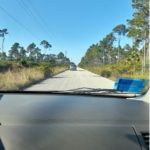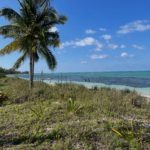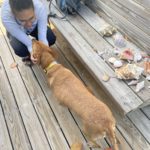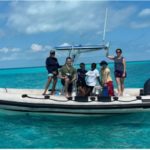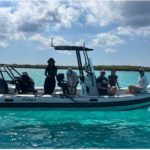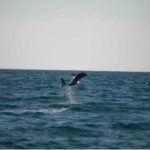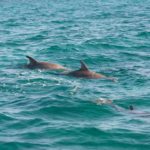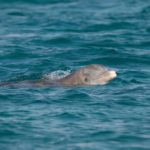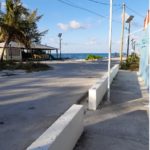Searching at Sandy Point: Day 1
The day started out early as we packed up and headed out from Friends of the Environment, in Marsh Harbour, to make our journey to Sandy Point where we are spending the rest of the trip. It was a 50-minute drive, and along the way, we saw the distinct line where the destruction of hurricane Dorian ended, and the forest became thick and green again instead of just dead trees standing like match sticks. Supposedly there are some ground-living parrots in the area but sadly we didn’t see any.
We arrived at Charlotte and Diane’s house in Sandy Point and were greeted by their lovely dogs Ginger and Harry, before going out in BMMRO’s two boats Steno and Sima to search for dolphins and sperm whales. However, first my team (Emily, Tristan, Le’Andra, Diane and Julie) headed out to drop a continuous hydrophone recorder at Rocky Point. This is the same recording device as we left at Sandy Cay reef earlier in the week and will stay at Rocky Point to collect baseline recordings as there is a plan to build a marina in that area. Tristan took the challenge and very successfully placed the recorder. Then we were on our way!
First we drove up to deep water and put our hydrophone out to listen for sperm whales. Sadly no luck. But we then received a very exciting radio from the other team (Grace, Jasmine, India, Sari, Vincent and Charlotte). They had heard whistles and clicks on their hydrophone! So we headed over to join their search. Unfortunately, even with the help of another sailor over the radio we didn’t manage to spot those dolphins. What then ensued was a search of all the areas around Sandy Point that Charlotte and Diane could think the dolphins might be. By 3pm we still had no success, despite following many a frigate bird.
After briefly enjoying this moment, we then got to work helping keep track of the dolphins so Diane and Charlotte could take photos of the dorsal for their photo-ID catalogue and the others on Charlotte’s boat could start recording with the hydrophone. Once this was completed, Julie then led Emily, Tristan and me in doing a focal follow of the group, while making behavioural observations. This was something we had been taught but had never done in the field, and it’s certainly easier in theory. We made different categories of behaviour and recorded when the dolphins showed these behaviours in 3-minute intervals, and gained some valuable experience along the way.
We stayed with the dolphins for over an hour until our boat headed back to shore, and Charlotte’s boat stayed to make some more acoustic recordings. They heard the dolphins making a popping noise both on the hydrophone and when they came to the surface. Vincent said this was a very unusual sound that he had only heard made by bottlenose dolphins in a few places.
Once everyone was ashore and the gear sorted, we went to our new accommodation to settle in before going back to Charlotte and Diane’s for some much-needed (and delicious!) pizza and half the students in our group gave talks about their research projects. Talks were given by Tristan about his PhD project, Emily and India about their master’s projects and Jasmine about her undergraduate honours project. This was great to hear about everyone’s work which is all so different and showed the broad scope of marine mammal research that is happening just within our small group.
After a long but eventful and fulfilling day, we traipsed home, all completely shattered by the excitement and sunshine, to sleep and be ready for tomorrow with hopefully more marine mammal sightings.
Written by Rosie Day (University of St. Andrews)
- The road from Marsh Harbour to Sandy Point. There is a notable demarcation line of pine trees stripped bare by Hurricane Dorian, and vegetated, living pine trees left relatively unaffected.
- The view of Sandy Point beach from Charlotte and Diane’s home.
- India giving the lovely Ginger, one of Charlotte and Diane’s dogs, her much deserved attention.
- From left to right: Diane, Tristan, Emily, Le’Andra, Rosie, and Julie, on the boat called Steno after Steno bredanensis, the Latin name for rough-toothed dolphins.
- From left to right: Sari, Jasmine, Charlotte, Vincent, Grace, and India, on the boat called Sima, named after Kogia sima, the Latin name for dwarf sperm whales.
- One of the four dolphins we encountered leaping out of the water. We suspect it had a dolphin on it’s belly, which it was trying to get rid of.
- Three of the bottlenose dolphin individuals found surfacing together. They can be identified using the unique markings and patterns on their dorsal fin that comes out of the water.
- A curious bottlenose dolphin individual showing it’s face and checking out the boat.
- A view of the dock at Sandy Point, right outside Pete & Gay’s, our accommodation for the week.
